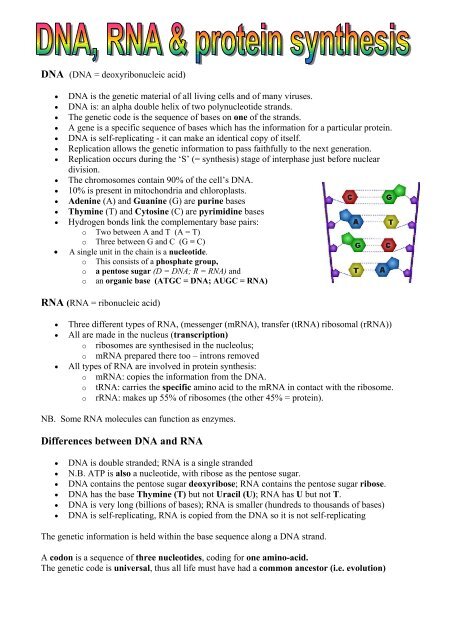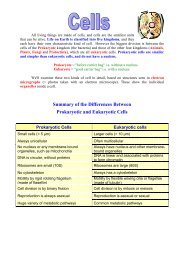DNA - BiologyMad A-Level Biology
DNA - BiologyMad A-Level Biology
DNA - BiologyMad A-Level Biology
Create successful ePaper yourself
Turn your PDF publications into a flip-book with our unique Google optimized e-Paper software.
<strong>DNA</strong> (<strong>DNA</strong> = deoxyribonucleic acid)<br />
• <strong>DNA</strong> is the genetic material of all living cells and of many viruses.<br />
• <strong>DNA</strong> is: an alpha double helix of two polynucleotide strands.<br />
• The genetic code is the sequence of bases on one of the strands.<br />
• A gene is a specific sequence of bases which has the information for a particular protein.<br />
• <strong>DNA</strong> is self-replicating - it can make an identical copy of itself.<br />
• Replication allows the genetic information to pass faithfully to the next generation.<br />
• Replication occurs during the ‘S’ (= synthesis) stage of interphase just before nuclear<br />
division.<br />
• The chromosomes contain 90% of the cell’s <strong>DNA</strong>.<br />
• 10% is present in mitochondria and chloroplasts.<br />
• Adenine (A) and Guanine (G) are purine bases<br />
• Thymine (T) and Cytosine (C) are pyrimidine bases<br />
• Hydrogen bonds link the complementary base pairs:<br />
o Two between A and T (A = T)<br />
o Three between G and C (G ≡ C)<br />
• A single unit in the chain is a nucleotide.<br />
o This consists of a phosphate group,<br />
o a pentose sugar (D = <strong>DNA</strong>; R = RNA) and<br />
o an organic base (ATGC = <strong>DNA</strong>; AUGC = RNA)<br />
RNA (RNA = ribonucleic acid)<br />
• Three different types of RNA, (messenger (mRNA), transfer (tRNA) ribosomal (rRNA))<br />
• All are made in the nucleus (transcription)<br />
o ribosomes are synthesised in the nucleolus;<br />
o mRNA prepared there too – introns removed<br />
• All types of RNA are involved in protein synthesis:<br />
o mRNA: copies the information from the <strong>DNA</strong>.<br />
o tRNA: carries the specific amino acid to the mRNA in contact with the ribosome.<br />
o rRNA: makes up 55% of ribosomes (the other 45% = protein).<br />
NB. Some RNA molecules can function as enzymes.<br />
Differences between <strong>DNA</strong> and RNA<br />
• <strong>DNA</strong> is double stranded; RNA is a single stranded<br />
• N.B. ATP is also a nucleotide, with ribose as the pentose sugar.<br />
• <strong>DNA</strong> contains the pentose sugar deoxyribose; RNA contains the pentose sugar ribose.<br />
• <strong>DNA</strong> has the base Thymine (T) but not Uracil (U); RNA has U but not T.<br />
• <strong>DNA</strong> is very long (billions of bases); RNA is smaller (hundreds to thousands of bases)<br />
• <strong>DNA</strong> is self-replicating, RNA is copied from the <strong>DNA</strong> so it is not self-replicating<br />
The genetic information is held within the base sequence along a <strong>DNA</strong> strand.<br />
A codon is a sequence of three nucleotides, coding for one amino-acid.<br />
The genetic code is universal, thus all life must have had a common ancestor (i.e. evolution)
Coding structures (Exons)<br />
• These are the parts of the <strong>DNA</strong> that contain the code for the synthesis of protein or RNA.<br />
• These coding sequences are present within genes.<br />
Non-coding Structures.<br />
• This is <strong>DNA</strong> that does not contain information for the synthesis of protein or RNA.<br />
• The non-coding sequences are found both between genes and within genes (= introns).<br />
• These non-coding sequences have been termed ‘junk <strong>DNA</strong>’ but they:<br />
o do play a role in gene expression (i.e. whether a gene is switched ‘on’ or ‘off’)<br />
o act as spacer material,<br />
o permit the synthesis of many new proteins and<br />
o play an important role in evolution.<br />
• Non-coding <strong>DNA</strong> makes up 95% of human <strong>DNA</strong>.<br />
• Non-coding <strong>DNA</strong> segments within genes are called introns.<br />
This takes place during the S stage of interphase<br />
<strong>DNA</strong> Replication<br />
• Nucleotides are synthesised in huge quantities in the cytoplasm.<br />
• An enzyme unzips the two complementary strands of <strong>DNA</strong>.<br />
• New complementary nucleotides link to the exposed bases on the<br />
separated strands.<br />
• The general name for this group of enzymes is <strong>DNA</strong> polymerase.<br />
• A new complementary strand is built along each ‘old’ strand.<br />
• Two <strong>DNA</strong>s, identical to the original and each other, are now present.<br />
• Each new <strong>DNA</strong> molecule is thus ‘half old’ and ‘half new’<br />
o ‘semi-conservative replication’.<br />
Gene - A section of <strong>DNA</strong> containing a<br />
particular sequence of bases that codes for a<br />
specific protein.<br />
Protein Synthesis - The transcription of a<br />
specific <strong>DNA</strong> base sequence into mRNA and its<br />
translation, by a ribosome, into a particular<br />
amino acid sequence forming a protein.<br />
Protein Synthesis
Genetic Code<br />
• The universal code that determines the function of all possible triplets of <strong>DNA</strong> / mRNA.<br />
• Most triplets specify a particular amino acid (= a codon).<br />
• Some triplets function as a start or stop signal for protein synthesis.<br />
• It is a degenerate code as a particular amino acid may be coded for by more than one codon.<br />
Process of Protein Synthesis – transcription and translation<br />
Transcription – <strong>DNA</strong> base sequence to mRNA base sequence<br />
• The ‘code’ for the protein is carried by one of the <strong>DNA</strong> strands in the gene.<br />
• An enzyme separates the two <strong>DNA</strong> strands at the gene locus exposing the gene sequence.<br />
• A complementary copy - mRNA - is made of the gene sequence –<br />
o new nucleotides form a complementary RNA strand<br />
o using the <strong>DNA</strong> gene sequence strand as a ‘master’<br />
o the enzyme RNA polymerase links the new nucleotides forming mRNA.<br />
• Uracil (U) is the complementary base to adenine in RNA, thymine (T) is not found in RNA.<br />
• The complementary RNA copy is called messenger RNA (mRNA).<br />
• The mRNA separates from the <strong>DNA</strong> strand and passes from the nucleus to the cytoplasm.<br />
Translation – mRNA base sequence to amino acid sequence.<br />
• A ribosome binds to the start point of the mRNA.<br />
• The ribosome will ‘decode’ the mRNA in sets of three bases (a codon).<br />
• Each codon specifies a particular amino acid.<br />
• The sequence of bases on the mRNA determines the sequence of amino acids in the<br />
protein – any change = a mutation<br />
• Two codons of the mRNA are exposed in turn.<br />
• Two complementary tRNA molecules attach to these two mRNA triplets.<br />
• The amino acids of the tRNA bond together (peptide bond – condensation reaction)<br />
• The leading tRNA detaches from its amino acid and from the mRNA.<br />
• The ribosome ‘moves’ to the next codon and another complementary tRNA attaches.<br />
• The newly arrived complementary tRNA then adds a new amino acid.<br />
• The process repeats, codon by codon, to the end of the mRNA (until a stop codon is reached).<br />
• The amino acid sequence is now complete.<br />
• The polypeptide (amino acid chain) folds giving the protein its normal functional shape.<br />
• Primary structure = amino-acid sequence (determined by <strong>DNA</strong> sequence)<br />
• Secondary structure = many H- bonds making<br />
o Alpha helix (very common) or<br />
o Beta-pleated sheet (rare – butterfly wings and silk)<br />
o Thus affected by pH, temperature<br />
• Tertiary structure = disulphide bridges and further H-bonds – forms active sites<br />
• Quaternary structure (rare) – only haemoglobin (Van der Waal’s forces)
Ribosomal RNA (rRNA)<br />
A ribosome is roughly 50% protein and 50% RNA (known as rRNA).<br />
Transfer RNA (tRNA)<br />
• tRNA is found in large amounts in the cytoplasm.<br />
• Single stranded but folded back on itself with three exposed bases<br />
(‘anticodon’) at one end and a particular amino acid at the opposite end.<br />
• tRNAs are ‘adapters’ linking amino acids to nucleic acids in protein<br />
synthesis.<br />
• There are 64 (4 x 4 x 4) possible triplets;<br />
• there are 61 tRNAs - the other 3 are ‘stop’ signals<br />
• There are only 20 different amino-acids, so<br />
o each amino-acid is coded for by more than one codon (tRNA);<br />
o thus the code is degenerate (or ‘semi-redundant’)<br />
Note: transcription occurs in the nucleus; translation occurs in the cytoplasm.<br />
© IHW March 2005
















